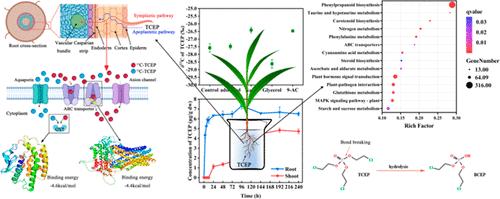稳定同位素和多组学研究揭示小麦(Triticum aestivum L.)对Tris(2-氯乙基)磷酸的吸收、转运和转化机制
IF 6.2
1区 农林科学
Q1 AGRICULTURE, MULTIDISCIPLINARY
引用次数: 0
摘要
以水培小麦(Triticum aestivum L.)为研究对象,采用化合物特异性稳定同位素和多组学方法,系统研究了TCEP在水培小麦(Triticum aestivum L.)中的吸收、转运和转化机制。结果表明,TCEP在根表皮上被快速吸附,然后通过水通道和阴离子通道被根吸收,这是一个依赖能量的活性过程。活性过程和阴离子通道优先转运含有轻碳同位素的TCEP,并主导TCEP的跨膜转运进入维管束。转录组学和代谢组学分析表明,基因编码的atp结合盒(ABC)转运体、紫色酸性磷酸酶(pap)和谷胱甘肽s -转移酶(GSTs)分别参与了TCEP的转运和转化。分子对接模拟表明,TCEP与ABC转运体/PAP的亲水性空腔和GST的疏水性空腔结合,氢键是重要的驱动力。本研究结果为今后有效降低食用植物中TCEP的风险提供了见解。本文章由计算机程序翻译,如有差异,请以英文原文为准。

Stable Isotope and Multiomics Reveal Uptake, Translocation, and Transformation Mechanisms of Tris(2-chloroethyl) Phosphate in Wheat (Triticum aestivum L.)
Uptake, translocation, and transformation mechanisms of tris(2-chloroethyl) phosphate (TCEP) in hydroponic wheat (Triticum aestivum L.) were systematically investigated using compound-specific stable isotope and multiomics analyses in this study. Results showed that TCEP was quickly adsorbed on root epidermis and then absorbed in roots via water and anion channels as well as an active process dependent on energy. Active process and anion channel preferentially translocated TCEP-containing light carbon isotopes and dominated the transmembrane transport of TCEP to enter vascular bundle. Transcriptomic and metabolomic analyses indicated gene-encoding ATP-binding cassette (ABC) transporters and purple acid phosphatases (PAPs) and glutathione S-transferases (GSTs) involved in TCEP transport and transformation, respectively. Molecular docking simulations showed that TCEP bound to the hydrophilic cavity of ABC transporter/PAP and hydrophobic cavity of GST, and hydrogen bonding was the important driving force. The results of this study offered insights for future effective mitigation of TCEP risk in edible plants.
求助全文
通过发布文献求助,成功后即可免费获取论文全文。
去求助
来源期刊
CiteScore
9.90
自引率
8.20%
发文量
1375
审稿时长
2.3 months
期刊介绍:
The Journal of Agricultural and Food Chemistry publishes high-quality, cutting edge original research representing complete studies and research advances dealing with the chemistry and biochemistry of agriculture and food. The Journal also encourages papers with chemistry and/or biochemistry as a major component combined with biological/sensory/nutritional/toxicological evaluation related to agriculture and/or food.

 求助内容:
求助内容: 应助结果提醒方式:
应助结果提醒方式:


